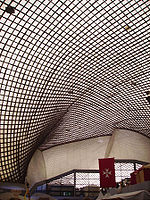Frei Otto
Frei Otto | |
|---|---|
| Born | Frei Paul Otto 31 May 1925 |
| Died | 9 March 2015 (aged 89) |
| Nationality | German |
| Occupation | Architect |
Frei Paul Otto (German:
Otto won the
Early life
Otto was born in
Career

He began a private practice in Germany in 1952. He earned a doctorate in tensioned constructions in 1954.[1] His saddle-shaped cable-net music pavilion at the Bundesgartenschau (Federal Garden Exposition) in Kassel 1955[2] brought him his first significant attention.
Otto specialised in lightweight
Until his death, Otto remained active as an architect and engineer, and as consultant to his protégé Mahmoud Bodo Rasch for a number of projects in the Middle East. One of his more recent projects was his work with Shigeru Ban on the Japanese Pavilion at Expo 2000 with a roof structure made entirely of paper, and together with SL Rasch GmbH Special and Lightweight Structures he designed a convertible roof for the Venezuelan Pavilion.[4] In an effort to memorialise the September 11 attacks and its victims as early as 2002, Otto envisioned the two footprints of the World Trade Center buildings covered with water and surrounded by trees; his plan includes a world map embedded in the park with countries at war marked with lights and a continuously updated board announcing the number of people killed in war from 11 September 2001, onward.[5]
On request of Christoph Ingenhoven, Otto designed the "Light eyes" for Stuttgart 21.[6] – drop-shaped overlights in the park, that descend onto the tracks to support the ceiling.[7][8] Otto remarked in 2010 that the construction should be stopped because of the difficult geology.[9][10]
Otto died on 9 March 2015; he was to be publicly announced as the winner of the 2015
List of buildings
This is a partial list of buildings designed by Otto:[12]
- 1957 – Tanzbrunnen pavilion Rheinpark Cologne, Germany
- 1967 – West Germany Pavilion at Expo 67 Montreal, Canada
- 1972 – Roof for Olympic Stadium, Munich, Germany
- 1974 – Convention Center in Mecca, Saudi Arabia
- 1975 – Multihalle, Mannheim, Germany
- 1977 – Umbrellas for 1977 Pink Floyd tour
- 1980 – Aviary at Munich Zoo, Germany
- 1985 – Tuwaiq Palace, Saudi Arabia, with Buro Happold
- 1987–91 – Housing at the International Building Exhibition Berlin, Germany
- 2000 – Roof structure of the Japanese Pavilion at Expo 2000, Hanover Germany (provided engineering assistance with Buro Happold and architectural collaboration with Shigeru Ban)
-
Interior view, West Germany Pavilion, Expo 67, Montreal, Canada
-
Multihalle in Mannheim
-
Institut für Leichte Flächentragwerke, University of Stuttgart
Awards (selected)
- 1974 – Thomas Jefferson Medal in Architecture[13]
- 1980 – Honorary doctorate of science from the University of Bath[14]
- 1982 – Großer BDA Preis[15]
- 1996/97 – Wolf Prize in Architecture[14]
- 2005 – RIBA[16]
- 2006 – Praemium Imperiale in Architecture[4]
- 2015 – Pritzker Architecture Prize[11][12]
See also
References
- ^ a b c d "Biography: Frei Otto". The Hyatt Foundation. Archived from the original on 9 November 2017. Retrieved 11 March 2015.
- )
- ISBN 978-0-316-47369-9. Archivedfrom the original on 6 July 2021. Retrieved 16 November 2023.
- ^ a b c "Frei Otto". Praemium Imperiale. Archived from the original on 24 September 2015. Retrieved 11 March 2015.
- Wall Street Journal. Archivedfrom the original on 4 March 2016. Retrieved 7 March 2017.
- ^ "Meilenstein in Stuttgart: Erster Musterkelch wurde betoniert". ingenhoven architects. 18 March 2016. Archived from the original on 23 July 2021. Retrieved 28 September 2020.
- ^ Werner Sobek: S21 Tiefbahnhof Stuttgart. Archived 13 June 2017 at the Wayback Machine
- ^ Video: Animation. Stuttgart 21 – Ein Bahnhof kommt unter die Erde. Archived 8 November 2017 at the Wayback Machine and pictures: Großprojekt Stuttgart 21: Wie der Bahnhof einmal aussehen soll. Archived 16 June 2021 at the Wayback Machine
- ^ Hans Monath, Andreas Böhme: Bahn soll bei Stuttgart 21 Notbremse ziehen. Archived 29 August 2010 at the Wayback Machine
- ^ Stuttgart 21-Architekt fordert den sofortigen Baustopp. Archived 20 May 2015 at the Wayback Machine
- ^ a b "Frei Otto, 2015 Laureate". Pritzker Architecture Prize. 10 March 2015. Archived from the original on 11 March 2015. Retrieved 11 March 2015.
- ^ a b c d Pritzker Prize for Frei Otto, German Architect, Announced After His Death Archived 3 February 2018 at the Wayback Machine, Robin Pogrebin, The New York Times, 10 March 2015
- ISBN 978-0-9755654-2-1.
- ^ ISBN 978-0-7277-2877-7. Archivedfrom the original on 16 November 2023. Retrieved 23 September 2020.
- ^ "Bund Deutscher Architektinnen und Architekten BDA". Bund Deutscher Architektinnen und Architekten BDA (in German). Retrieved 18 November 2023.
- ^ The man with the golden pen, Building.co.uk, 2005 issue 08
Further reading
- Conrad Roland: Frei Otto – Spannweiten. Ideen und Versuche zum Leichtbau. Ein Werkstattbericht von Conrad Roland. Ullstein, Berlin, Frankfurt/Main und Wien 1965.
- Philip Drew: Frei Otto – Form and Structure, 1976, ISBN 978-0-258-97053-9
- Philip Drew: Tensile Architecture, 1979, ISBN 978-0-258-97012-6
- Muriel Emanuel, Dennis Sharp: "Contemporary Architects", New York: St. Martin's Press. 1980. p. 600. ISBN 0-312-16635-4
- Frei Otto, Bodo Rasch: Finding Form: Towards an Architecture of the Minimal, 1996, ISBN 3-930698-66-8
- Winfried Nerdinger: Frei Otto, Complete Works: Lightweight Construction – Natural Design, 2005, ISBN 978-3-7643-7231-6- published on the occasion of the exhibition Frei Otto Lightweight Construction, Natural Design at the Architekturmuseum der Technischen Universität München in der Pinakothek der Moderne from 26 May to 28 August 2005, and cataloguing over 200 buildings and projects dating from the years 1951-2004
External links
- Frei Otto at archINFORM
- Frei Otto's official website
- Frei Otto: Spanning The Future Documentary film's official Website
- Japan Pavilion Expo 2000 – About the roof structure
- SL Rasch GmbH Homepage
- Last recorded interview with Frei Otto, about his life and receiving the Pritzker Prize
- Uncube Nr. 33 Frei Otto – by uncube magazine



